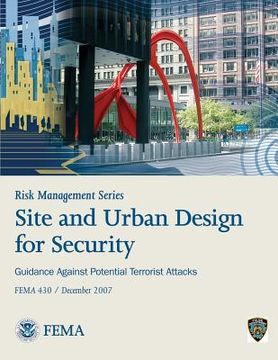Risk Management Series: Site and Urban Design for Security - Guidance Against Potential Terrorist Attacks (FEMA 430 / December 2007) (en Inglés)
Reseña del libro "Risk Management Series: Site and Urban Design for Security - Guidance Against Potential Terrorist Attacks (FEMA 430 / December 2007) (en Inglés)"
The Federal Emergency Management Agency (FEMA) has developed this publication, Site and Urban Design for Security: Guidance against Potential Terrorist Attacks, to provide information and design concepts for the protection of buildings and occupants, from site perimeters to the faces of buildings. The intended audience includes the design community of architects, landscape architects, engineers and other consultants working for private institutions, building owners and managers and state and local government officials concerned with site planning and design. Immediately after September 11, 2001, extensive site security measures were put in place, particularly in the two target cities of New York and Washington. However, many of these security measures were applied on an ad hoc basis, with little regard for their impacts on development pat-terns and community character. Property owners, government entities and others erected security barriers to limit street access and installed a wide variety of security devices on sidewalks, buildings, and transportation facilities. The short-term impacts of these measures were certainly justified in the immediate aftermath of the events of September 11, 2001, but traffic patterns, pedestrian mobility, and the vitality of downtown street life were increasingly jeopardized. Hence, while the main objective of this manual is to reduce physical damage to buildings and related infrastructure through site design, the purpose of FEMA 430 is also to ensure that security design provides careful attention to urban design values by maintaining or even enhancing the site amenities and aesthetic quality in urban and semi-urban areas. This publication focuses on site design aimed to protect buildings from attackers using vehicles carrying explosives. These represent the most serious form of attack. Large trucks enable terrorists to carry very large amounts of explosives that are capable of causing casualties and destruction over a range of many hundreds of yards. Perimeter barriers and protective design within the site can greatly reduce the possibility of vehicle penetration. Introduction of smaller explosive devices, carried in suitcases or backpacks, must be prevented by pedestrian screening methods. Site design for security, however, may impact the function and amenity of the site, and barrier and access control design may impact the quality of the public space within the adjacent neighborhood and community. The designer's role is to ensure that public amenity and the aesthetics of the site surroundings are kept in balance with security needs. This publication contains a number of examples in which the security/ amenity balance has been maintained through careful design and collaboration between designers and security experts. Much security design work since September 11, 2001, has been applied to federal and state projects, and these provide many of the design examples shown. At present, federal government projects are subject to mandatory security guidelines that do not apply to private sector projects, but these guidelines provide a valuable information resource in the absence of comparable guidelines or regulations applying to private development. Operations and management issues and the detailed design of access control, intrusion alarm systems, electronic perimeter protection, and physical security devices, such as locking devices, are the province of the security consultant and are not covered here, except as they may impact the conceptual design of the site. Limited information only is provided on some aspects of chemical, biological and radiological (CBR) attacks that are significant for site designers; extensive discussion of approaches to these threats can be found in FEMA 426.

